Erosion affects rocks by gradually breaking them down and reshaping landscapes over time. At rockscapes.net, we understand that understanding these processes is key to appreciating the beauty and dynamism of our natural world, including the stunning rock formations in your own backyard. Discover how to use natural stone to enhance your landscape.
1. What Is Erosion and How Does It Differ from Weathering?
Erosion is the geological process where rocks and soil are worn away and transported by natural forces. While often confused with weathering, erosion specifically involves the movement of rock fragments, distinguishing it from weathering, which is the in-situ breakdown of rocks.
Erosion and weathering are both vital components of the rock cycle, working together to shape the Earth’s surface. Weathering weakens and disintegrates rocks, while erosion moves these broken pieces to new locations. Understanding the distinction is crucial for anyone involved in landscape design or construction, as it impacts material selection and long-term stability of rock features.
2. What Role Does Gravity Play in Rock Erosion?
Gravity contributes to rock erosion by causing the movement of rocks and sediments from higher to lower elevations. This process, known as gravitational erosion, often involves landslides and rockfalls, where loosened material is transported downhill.
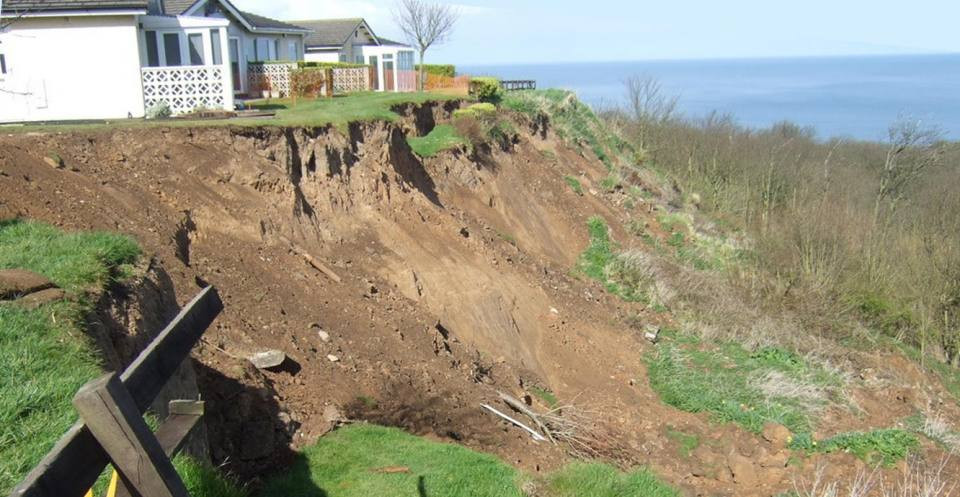 Landslide at Knipe Point
Landslide at Knipe Point
The landslide at Knipe Point in the UK shows loose soil and rocks sliding down the shore cliff due to gravitational erosion. BGS © UKRI.
Gravity’s influence is particularly evident in mountainous regions and steep slopes, where the force of gravity can overcome the resistance of rocks and soil. Landslides, for example, are a dramatic manifestation of gravitational erosion, often triggered by heavy rainfall or seismic activity. The material transported by gravity can then be further eroded by other processes, such as rivers or glaciers.
3. How Does Wind Cause Erosion of Rocks?
Wind erodes rocks by carrying dust and sand particles that act as abrasive agents, slowly wearing away exposed surfaces. This process, known as aeolian erosion, can create unique rock formations and landscapes, particularly in arid and semi-arid regions.
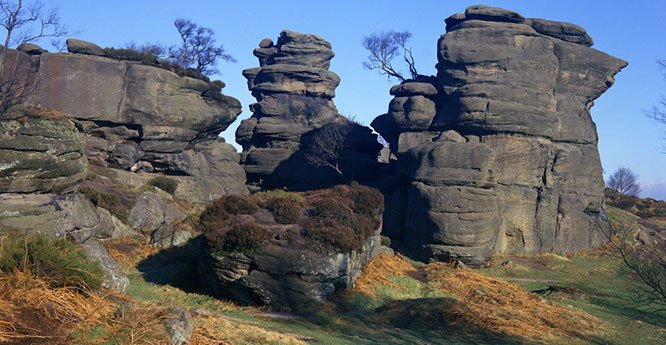 Brimham Rocks. Looking N.
Brimham Rocks. Looking N.
The Brimham Rocks in North Yorkshire shows wind erosion of horizontally bedded sedimentary rocks. BGS © UKRI.
The impact of wind erosion is particularly visible in desert landscapes, where wind-blown sand sculpts rocks into unusual shapes. According to research from Arizona State University’s School of Earth and Space Exploration, wind erosion is a significant factor in the formation of desert pavements and sand dunes. The abrasive action of wind-borne particles can also damage buildings and infrastructure, highlighting the importance of understanding and mitigating wind erosion in certain areas.
4. What Is the Impact of Rain on Rock Erosion?
Rain contributes to rock erosion through rain-splash erosion, where the impact of raindrops dislodges soil and weathered material. Additionally, heavy rainfall can carry sediment into streams and rivers, further eroding the landscape.
 Gullies in a cliff face made of dark-coloured rock, forming a landslide on a beach
Gullies in a cliff face made of dark-coloured rock, forming a landslide on a beach
Rain gullies in Black Ven landslide, Lyme Regis, Dorset. BGS © UKRI.
Rainfall is a major driver of erosion, especially in areas with steep slopes and erodible soils. The erosive power of rain is influenced by factors such as rainfall intensity, soil type, and vegetation cover. In urban environments, heavy rainfall can lead to increased runoff and soil erosion, impacting water quality and infrastructure. Proper drainage and erosion control measures are essential to minimize the negative effects of rain-induced erosion.
5. How Do Rivers Contribute to Erosion and Deposition?
Rivers erode the Earth by carving channels, transporting sediment, and depositing material downstream. This process shapes landscapes, creates floodplains, and influences the course of rivers over time.
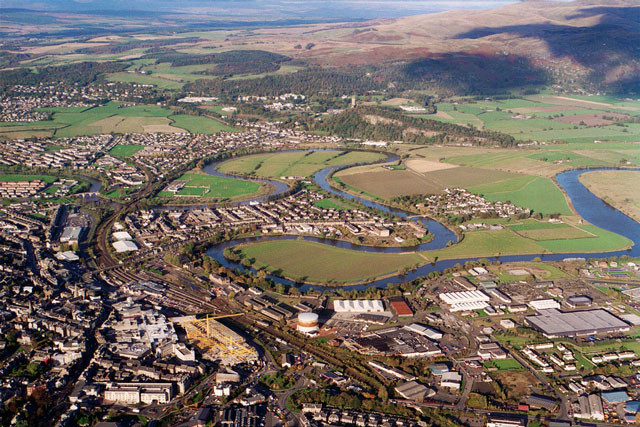 Aerial view of the meander of the River Forth outside Stirling.
Aerial view of the meander of the River Forth outside Stirling.
The aerial view of the meanders of the River Forth outside Stirling. BGS © UKRI.
Rivers act as both agents of erosion and deposition, constantly reshaping the landscape through their dynamic flow. The erosive power of rivers is influenced by factors such as water velocity, sediment load, and channel gradient. As rivers flow, they erode the surrounding land, transporting sediment downstream. This sediment is eventually deposited in areas where the river’s velocity decreases, such as floodplains and deltas. The balance between erosion and deposition determines the overall morphology of the river and its surrounding landscape.
6. What Is the Effect of Oceans on Coastal Erosion?
Oceans erode coastlines through wave action and currents, gradually wearing away beaches and cliffs. This process can lead to significant changes in coastal landscapes, impacting human settlements and ecosystems.
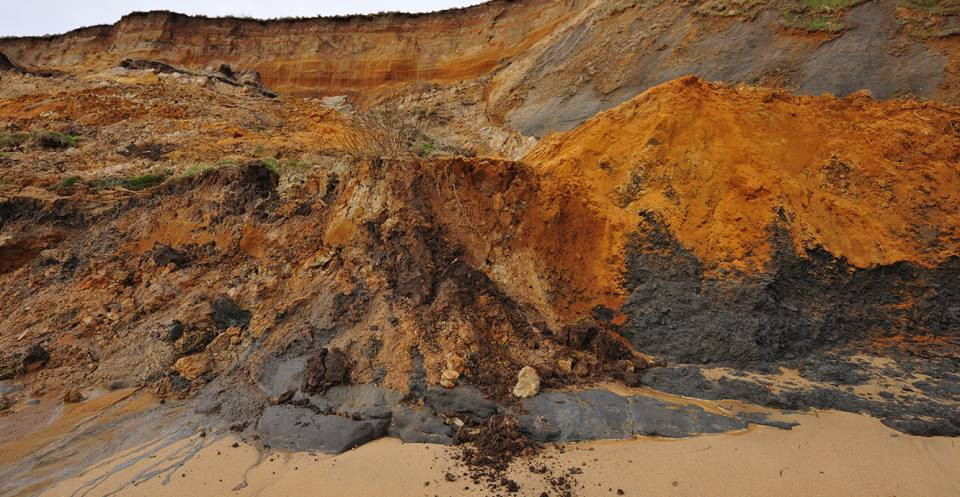 Coastal section showing erosion and cliff retreat, Walton-on-the-Naze, Essex.
Coastal section showing erosion and cliff retreat, Walton-on-the-Naze, Essex.
The coastal erosion at Newbiggin Cliff near Filey, North Yorkshire shows crashing waves loosen rocks in the cliff face, making the land retreat. BGS © UKRI.
Ocean waves and currents are powerful agents of erosion, constantly reshaping coastlines through their relentless action. Waves erode beaches by washing away sand and sediment, while currents transport this material along the coast. Cliff erosion occurs as waves pound against the base of cliffs, weakening the rock and causing it to collapse. Coastal erosion is a natural process, but it can be exacerbated by human activities such as construction and removal of vegetation. Coastal management strategies, such as beach nourishment and seawall construction, are often implemented to protect shorelines from erosion.
7. How Do Glaciers Cause Erosion of Rocks and Landscapes?
Glaciers erode rocks by grinding and scraping them as they flow, leaving behind distinctive landforms such as U-shaped valleys and glacial striations. The weight and movement of glaciers can significantly alter landscapes over time.
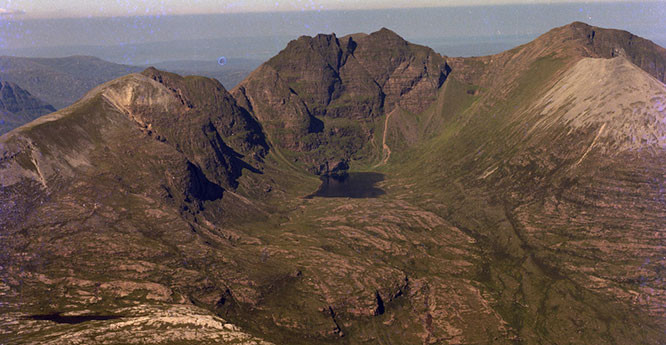 Oblique aerial view of the east flank of An Teallach, Ross and Cromarty. The lower slopes of ice-scoured Torridonian sandstone contrast with the frost-shattered slopes on the ridge and the Glas Mheall Liath quartzite blockslopes.
Oblique aerial view of the east flank of An Teallach, Ross and Cromarty. The lower slopes of ice-scoured Torridonian sandstone contrast with the frost-shattered slopes on the ridge and the Glas Mheall Liath quartzite blockslopes.
An Teallach, in Ross and Cromarty, is a mountain of Torridonian sandstone sculpted by glacial action. BGS © UKRI.
Glaciers are powerful agents of erosion, capable of carving out entire valleys and reshaping mountain ranges. The weight and movement of glacial ice exert tremendous pressure on the underlying bedrock, causing it to fracture and erode. Glaciers also transport large amounts of sediment, including rocks and debris, which further contribute to the erosive process. As glaciers retreat, they leave behind distinctive landforms such as U-shaped valleys, cirques, and moraines. Glacial erosion has played a significant role in shaping the landscapes of many regions, particularly in high-latitude and alpine areas.
8. How Does Erosion Impact Different Types of Rocks Differently?
The effect of erosion varies depending on the type of rock. Softer rocks like sandstone erode more quickly than harder rocks like granite. The composition and structure of the rock influence its resistance to erosional forces.
| Rock Type | Erosion Resistance | Notable Features |
|---|---|---|
| Sandstone | Low | Composed of loosely cemented sand grains, easily eroded by wind and water. |
| Limestone | Medium | Soluble in slightly acidic water, leading to dissolution and karst formation. |
| Granite | High | Hard, crystalline rock resistant to weathering and erosion. |
| Basalt | Medium to High | Dense, volcanic rock that can form columnar structures resistant to erosion. |
| Shale | Low | Composed of compacted clay, easily eroded and prone to landslides. |
Understanding the erodibility of different rock types is crucial for landscape design and construction. For example, using erosion-resistant rocks like granite can help ensure the stability and longevity of rock features in your landscape.
9. How Can We Protect Rocks from Erosion in Landscaping?
Protecting rocks from erosion in landscaping involves several strategies, including proper drainage, vegetation cover, and the use of erosion-resistant materials. Minimizing erosion helps maintain the beauty and integrity of rock features in your landscape.
- Proper Drainage: Ensure that water is directed away from rock features to prevent excessive erosion.
- Vegetation Cover: Plant vegetation around rock features to help stabilize the soil and reduce erosion.
- Erosion-Resistant Materials: Use erosion-resistant rocks like granite for landscaping projects to minimize weathering and erosion.
- Retaining Walls: Construct retaining walls to support slopes and prevent soil erosion around rock features.
- Mulch: Apply mulch around plants and rock features to protect the soil from erosion and retain moisture.
By implementing these strategies, you can protect your rock features from erosion and ensure their longevity and beauty. Rockscapes.net offers a variety of erosion control products and solutions to help you maintain your landscape.
10. What Are Some Stunning Examples of Erosion-Shaped Landscapes in the USA?
The USA boasts numerous stunning landscapes shaped by erosion, including the Grand Canyon, Arches National Park, and Bryce Canyon. These natural wonders showcase the power of erosion to create unique and awe-inspiring formations.
| Landscape | Location | Key Features |
|---|---|---|
| Grand Canyon | Arizona | Deep canyon carved by the Colorado River, showcasing millions of years of erosion. |
| Arches National Park | Utah | Over 2,000 natural sandstone arches formed by wind and water erosion. |
| Bryce Canyon | Utah | Unique geological formations called hoodoos, created by frost and rain erosion. |
| Badlands | South Dakota | Eroded buttes, pinnacles, and spires formed by wind and water erosion. |
| Columbia River Gorge | Oregon and Washington | Deep canyon carved by the Columbia River, featuring waterfalls and basalt cliffs. |
These landscapes demonstrate the remarkable ability of erosion to shape our planet, creating breathtaking scenery and geological wonders.
11. How Does Human Activity Accelerate Rock Erosion?
Human activities such as deforestation, construction, and mining can significantly accelerate rock erosion. Removing vegetation, disturbing soil, and altering natural drainage patterns can increase erosion rates and lead to environmental damage.
- Deforestation: Removing trees and vegetation exposes soil to wind and water, increasing erosion rates.
- Construction: Construction activities often involve clearing land and disturbing soil, leading to increased erosion.
- Mining: Mining operations can destabilize slopes and expose rocks to weathering and erosion.
- Agriculture: Intensive farming practices can deplete soil nutrients and increase erosion rates.
- Urbanization: Urban development can alter natural drainage patterns and increase runoff, leading to increased erosion.
It’s essential to implement sustainable land management practices to minimize the impact of human activities on rock erosion.
12. What Are Some Long-Term Effects of Rock Erosion on the Environment?
The long-term effects of rock erosion on the environment include soil loss, sedimentation of waterways, and changes in landscape morphology. Erosion can also impact water quality and ecosystems, affecting plant and animal life.
- Soil Loss: Erosion removes topsoil, which is essential for plant growth and agriculture.
- Sedimentation: Eroded sediment can accumulate in rivers, lakes, and reservoirs, affecting water quality and aquatic habitats.
- Landscape Changes: Erosion can alter the shape of landscapes, creating new landforms and modifying existing ones.
- Water Quality Impacts: Erosion can transport pollutants and nutrients into waterways, affecting water quality and aquatic ecosystems.
- Ecosystem Effects: Erosion can disrupt ecosystems by altering habitats and affecting plant and animal life.
Understanding the long-term effects of rock erosion is crucial for developing sustainable land management strategies and protecting our environment.
13. How Can I Identify Signs of Erosion in My Rock Garden?
Identifying signs of erosion in your rock garden is essential for taking timely action to prevent further damage. Look for exposed soil, gullies, sediment buildup, and displacement of rocks.
- Exposed Soil: Areas of bare soil where vegetation has been removed or eroded away.
- Gullies: Small channels or trenches formed by running water.
- Sediment Buildup: Accumulation of sediment on surfaces or in drainage areas.
- Displacement of Rocks: Rocks that have been moved from their original positions.
- Undermining: Soil being eroded from beneath rocks, causing them to become unstable.
Regularly inspecting your rock garden for these signs can help you identify and address erosion issues before they become more severe.
14. What Types of Rocks Are Best for Erosion Control?
Rocks best suited for erosion control are typically dense, durable, and resistant to weathering. Granite, basalt, and quartzite are excellent choices for erosion control projects due to their strength and longevity.
| Rock Type | Key Properties | Best Uses |
|---|---|---|
| Granite | Hard, durable, resistant to weathering | Retaining walls, riprap, landscape boulders |
| Basalt | Dense, volcanic rock, resistant to erosion | Erosion control structures, retaining walls, stream bank stabilization |
| Quartzite | Hard, metamorphic rock, resistant to weathering and abrasion | Erosion control, retaining walls, decorative landscaping |
| Limestone | Can be used, but more susceptible to dissolution in acidic conditions | Retaining walls, decorative landscaping in areas with neutral soil pH |
| Sandstone | Less durable, best used in areas with minimal water exposure | Decorative landscaping, pathways, patios |
Choosing the right type of rock for erosion control depends on the specific project requirements and environmental conditions.
15. What Are Some DIY Methods to Minimize Rock Erosion in My Yard?
DIY methods to minimize rock erosion in your yard include creating terraces, installing drainage systems, and planting ground cover. These simple techniques can help stabilize soil and reduce erosion rates.
- Terraces: Create terraces on slopes to slow down water flow and reduce erosion.
- Drainage Systems: Install drainage systems to direct water away from vulnerable areas.
- Ground Cover: Plant ground cover to stabilize soil and reduce erosion.
- Mulch: Apply mulch to protect soil from erosion and retain moisture.
- Rock Barriers: Create rock barriers to slow down water flow and trap sediment.
These DIY methods can be effective in minimizing rock erosion and protecting your yard from damage.
16. How Does Erosion Affect the Value of My Property?
Erosion can negatively affect the value of your property by damaging landscaping, destabilizing structures, and reducing curb appeal. Preventing erosion is essential for maintaining the value and integrity of your property.
- Landscaping Damage: Erosion can wash away soil, damage plants, and disfigure rock features, reducing the aesthetic appeal of your landscape.
- Structural Damage: Erosion can undermine foundations, destabilize retaining walls, and damage other structures on your property.
- Reduced Curb Appeal: Erosion can create unsightly areas of bare soil, gullies, and sediment buildup, reducing the curb appeal of your property.
- Property Value Decline: The cumulative effects of erosion can lead to a decline in property value.
- Increased Maintenance Costs: Properties affected by erosion often require increased maintenance and repair costs.
Protecting your property from erosion is a smart investment that can help maintain its value and prevent costly repairs.
17. What Are the Latest Trends in Erosion Control for Landscaping?
Latest trends in erosion control for landscaping include using native plants, permeable pavers, and bioengineering techniques. These sustainable approaches help minimize erosion while enhancing the beauty and ecological value of your landscape.
| Trend | Description | Benefits |
|---|---|---|
| Native Plants | Using plants native to the local area | Adaptable to local conditions, require less maintenance, provide habitat for wildlife |
| Permeable Pavers | Pavers that allow water to infiltrate into the ground | Reduce runoff, recharge groundwater, minimize erosion |
| Bioengineering | Using natural materials like logs and vegetation to stabilize slopes | Environmentally friendly, cost-effective, aesthetically pleasing |
| Erosion Control Blankets | Biodegradable blankets that protect soil from erosion while vegetation establishes | Effective in stabilizing slopes, preventing soil loss, promoting vegetation growth |
| Compost Blankets | Applying a layer of compost to protect soil and promote plant growth | Improves soil health, reduces erosion, provides nutrients for plants |
Incorporating these trends into your landscaping projects can help you create a sustainable and erosion-resistant landscape.
18. What Are Some Common Misconceptions About Rock Erosion?
Common misconceptions about rock erosion include the belief that it only occurs in dramatic events like landslides and that it is solely a natural process. In reality, erosion is a continuous process influenced by both natural and human factors.
| Misconception | Reality |
|---|---|
| Erosion only occurs in dramatic events | Erosion is a continuous process that occurs gradually over time. |
| Erosion is solely a natural process | Human activities can significantly accelerate erosion rates. |
| Erosion is always a negative process | Erosion can create unique and beautiful landscapes. |
| All rocks erode at the same rate | Different types of rocks have different resistance to erosion. |
| Erosion control is too expensive for homeowners | There are many affordable DIY methods to minimize rock erosion. |
Understanding the reality of rock erosion can help you make informed decisions about land management and erosion control.
19. How Can Rockscapes.net Help Me with Erosion Control in My Landscape?
Rockscapes.net can help you with erosion control in your landscape by providing a wide range of erosion control products, expert advice, and design inspiration. We offer solutions for every budget and project size, ensuring your landscape remains beautiful and stable.
At Rockscapes.net, we understand the challenges of erosion control and offer a comprehensive range of services to help you protect your landscape. Our team of experts can provide personalized advice and design solutions tailored to your specific needs. Whether you’re looking for erosion-resistant rocks, drainage systems, or bioengineering techniques, we have the products and expertise to help you create a sustainable and erosion-resistant landscape.
20. FAQ About How Erosion Affects Rocks
Here are some frequently asked questions about how erosion affects rocks:
- What is the difference between erosion and weathering? Erosion involves the movement of rock fragments, while weathering is the breakdown of rocks in place.
- What are the main causes of erosion? The main causes of erosion include gravity, wind, rain, rivers, oceans, and glaciers.
- How does erosion affect different types of rocks? Softer rocks like sandstone erode more quickly than harder rocks like granite.
- What human activities can accelerate erosion? Deforestation, construction, and mining can significantly accelerate erosion rates.
- How can I protect rocks from erosion in my landscape? Strategies include proper drainage, vegetation cover, and the use of erosion-resistant materials.
- What are some signs of erosion in a rock garden? Look for exposed soil, gullies, sediment buildup, and displacement of rocks.
- What types of rocks are best for erosion control? Granite, basalt, and quartzite are excellent choices for erosion control projects.
- How does erosion affect property value? Erosion can damage landscaping, destabilize structures, and reduce curb appeal, negatively affecting property value.
- What are the latest trends in erosion control for landscaping? Trends include using native plants, permeable pavers, and bioengineering techniques.
- How can Rockscapes.net help me with erosion control? Rockscapes.net provides a wide range of erosion control products, expert advice, and design inspiration.
Interested in learning more about how to protect your landscape from erosion and incorporate beautiful rock features? Visit rockscapes.net or contact us at Address: 1151 S Forest Ave, Tempe, AZ 85281, United States. Phone: +1 (480) 965-9011. Our team of experts is ready to help you create a sustainable and stunning outdoor space.